Keywords
|
| Renewable energy, Rice Husk, Rice Clusters, Parboiling, Plants, Bangladesh, Bangladesh |
INTRODUCTION
|
| Now a day’s worldwide energy crisis is one of the great problem. The interest in renewable energy has been revived over last few years, especially after global awareness regarding the ill effects of fossil fuel burning. The use of renewable energy technology to meet the energy demands has been steadily increasing for the past few years, however, the important drawbacks associated with renewable energy systems are their inability to guarantee reliability and their lean nature. Bangladesh is situated between 20.30 - 26.38 degrees north latitude and 88.04 - 92.44 degrees east latitude. Placed between the Bay of Bengal and the Himalayas, Bangladesh is a South Asian country with a land area of 144,000 sq. kms. populated by around 150 million people. During summer, the rural areas face a severe load shedding. Three quarters of Bangladesh population live in the rural areas. Development of rural areas as well as expanding rural electrification is the key to the prosperity. The country's main endowments are fertile agricultural land, vast human resources, relatively abundant water, and natural gas. The agricultural land here is devoted mainly to rice and jute cultivation, although wheat and maize production has increased in recent years. Electricity and natural gas are the major sources of power in Bangladesh. Biomass is by far the dominant energy source in Bangladesh [1]. Approximate land use for agriculture is 54.5%, while the forest covers 17.6% of total land area of the country. About 46% of traditional biomass energy is supplied from agricultural residues such as rice straw and rice husk from rice plants, bagasse from sugarcane and jute stick [2]. Rice straw and rice bran are used as feed for cattle, poultry, fish etc. where the rice husk is used as energy. Husk Power Systems (HPS) lighted the first village from its first 100% biomass based power plant that uses discarded rice husks to generate electricity in August 2007. On an average, each power plant serves about 400 households and replaces approximately 42,000 litres of kerosene and 18,000 litres of diesel per year. The rice husk is one of the agriculture-based fuel materials in the world that can be feasibly collectible. Rice husk is a by-product of major food crop rice. The husk is the coating for the seeds of the rice plant. Rice husk have the following properties: Dimension is approximately 6 to 10 mm x 3 to 4 mm; Bulk density is around 100-120 kg/m3; Moisture content is approximately 10-14%; Net calorific value is approximately 14 MJ/kg. The chemical components of rice husk are cellulose (44.83%), hemicelluloses (35.3%), and lignin (19.87%). The lower heating value of rice husk is considered fairly as 14 MJ/kg, where the higher heating value of rice husk is considered fairly as 19 MJ/kg. Rice milling industry generates a lot of rice husk during milling of paddy which comes from the fields. This rice husk is mostly used as a fuel in the boilers for processing of paddy. |
BACKGROUND AND MOTIVATION
|
| As of 2011, Husk Power Systems provides power approximately 25,000 households in more than 250 villages serves 150,000 people through its 60 mini-power plants systems that each generate 35 to 100 kilowatts of power in villages in India's states of Bihar, Tamil Nadu and West Bengal, providing up to eight hours of power, primarily during the evening hours when illumination is needed [3] [4]. In global context, annual rice husk production is 137 million tonnes whereas, in Bangladesh, about 9.0 million tonnes of rice husk is produced. Figure 1 shows the top ten rice husk producing country in the world in 2007 [6]. Figure 2 shows the projection of future rice production in Bangladesh. Over last 30 years, there has been an increasing trend of rice husk energy production [5]. |
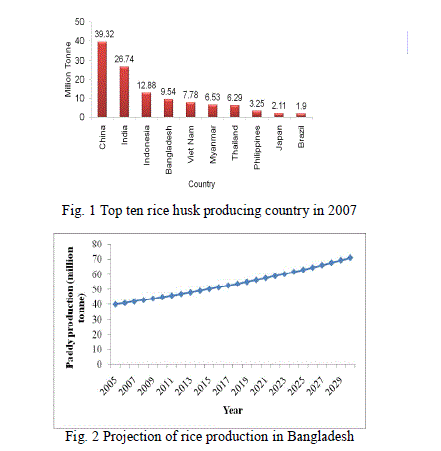 |
| The production of rice is projected using the growth of 2.35%. The growth is calculated from the average growth of rice production data from 1971 to 2009. |
RICE HUSK CLUSTERS IN BANGLADESH
|
| About 4 – 4.5 million metric tons (MT) of paddy is annually produced in the Bangladesh [2]. A 20% yield of input paddy leads to a production of 8 - 9,000,000 metric tons rice husk annually. There are over one hundred thousand rice mills located in a scattered manner all over the country with four ‘cluster’ areas according to the Rice Mill Owners’ Association of Bangladesh. Over ninety percent of these rice mills are reported to be in smaller capacity ranges, i.e. < 20 – 25 MT/day of paddy processing capacity. The number of lower-midsized rice mills (with paddy processing capacity range : > 25 - 50 MT/day) are reported to be about 490 and that of mid to large sized rice mills (30- 120 MT/day) are about 50 units. IDCOL already financed two such projects in Kapasia, near Dhaka and recently one in Thakurgaon sadar, Thakurgaon. Hence, based on preliminary surveys by Bangladesh Rice Research Institute, BRRI and information from Rice Mill Owners’ Association, typically at least over 500 rice mills are located in these cluster areas [2]. Taking an average (lower-mid) capacity range of about 100-200 kW, there is a 50-100 MW power market in these cluster areas. Areas like Dinajpur, Sherpur etc. are having intermittent power supply which often leads to less production for these rice mills and also other energy craving small enterprises and local dwellers are potential consumers for future rice husk based biomass power plant. Figure 3 shows rice husk clusters in Bangladesh [2] [7]. |
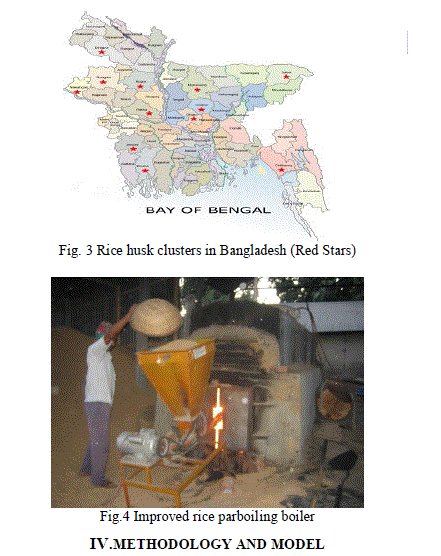 |
METHODOLOGY AND MODEL
|
| There are main two sectors of rice process such as household level process and processed in rice mills. Husk obtained from household level process cannot be collected due to its wide spread localization. Therefore, husk from household level process is not considered as supply source of husk for electricity generation. Paddy processed in rice mill is considered the source of husk supply. There are several rice processing zones in the country. Major rice processing zones or ‘cluster’ areas are distinguished as - (i) Dinajpur (North Bengal) (ii) Sherpur (near Bogra) (iii) Ishawardi (Pabna) (iv) Naogaon and (v) Kaliakoir (near Dhaka), where most of the rice mills are located in close proximity to each other. To conduct the investigation three rice processing zones were selected to estimate potential husk available for electricity generation. The selected rice clusters are located at Naogaon, Bogra, and Ishawrdi. A survey questionnaire was used to collect the information on monthly quantity of paddy processed, amount of husk produced, amount of husk consumed for rice processing purposes and the surplus amount of rice husk. Another study is conducted to estimate the total electricity generation from rice husk in Bangladesh. LEAP (Long-range Energy Alternative Planning System) tool is used to make three different scenarios for consumption of energy. Bangladesh has reportedly over one hundred thousand Rice Mills - large, medium and small. They process paddy, using mostly the parboiling practice. The rice mills use the thermal energy of steam generated in boilers, which are fired by rice husk - a by-product’s of paddy processing in the rice mills and which is globally well-known as very convenient source of dry biomass energy of reasonable heat value. With a few exceptions, presently most of the ‘boilers’, used in these rice mills of Bangladesh are very inefficient. This results in a huge wastage of rice husk, which is an important source of biomass. Preliminary estimates are indicative that at least 50% of the rice husk produced could be saved and made surplus for its better use as input for small power generation. Figure 4 shows the improved rice parboiling boiler which consumes less rice husk to boil each tonne of paddy. Rice husk consumption can be reduced by using improved parboiling boiler. |
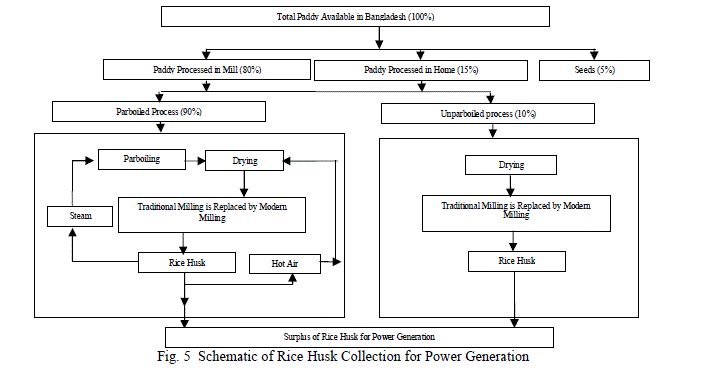 |
| Figure 5 shows the simple schematic of Rice Husk Collection for power generation.At present all boilers used are traditional type. In scenario-1, it is assumed that 95% of traditional boiler is to be replaced by improved boiler to reduce the husk consumption for parboiled process. In scenario-2, coverage of parboiled process is reduced to 50% from 90% (reference scenario). The husk consumption is reduced to 4.55 million tonnes (Scenario-1) and 3.20 million tonne (Scenario-2) from 6.48 million tonnes (reference). |
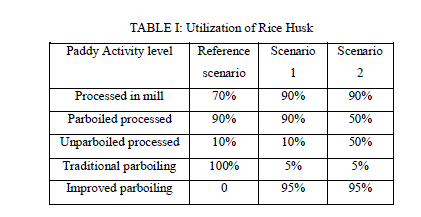 |
| Utilization of rice husk is shown in Table I. Rice husk consumption can be reduced by some assumptions. Figure 6 shows the rice husk consumption scenarios. In scenario – I husk consumptions is less than reference, where husk consumption is very low in scenario – II. The surplus amount of husk is calculated deducting the consumed amount of husk from total potential of husk. There is a huge potential to save rice husk by changing the technology for parboiling. |
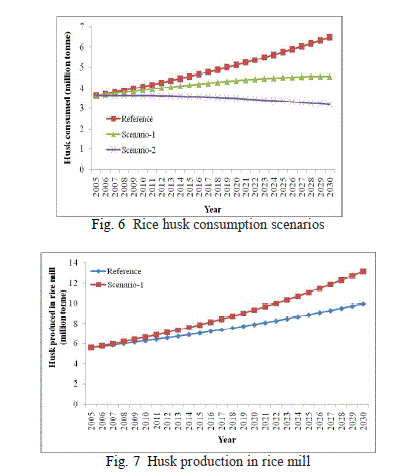 |
| Surplus of rice husk can be collected to generate power. Husk produced in rice mill could be increased by increasing the amount of processed paddy in mill. As a result the husk production is increased from 9.96 million tonnes (reference scenario) to 13.16 million tonnes. |
RICE HUSK POTENTIAL PROFILES
|
| Amount of electricity generated from rice husk depends on the amount of raw material and type of technology used for energy conversion. There are several technologies for electricity generation from biomass. In the present study steam turbine and gasification technology are considered for estimating the potential of electricity generated from surplus amount of husk from different scenarios. Figure 8 to Figure 13 show the potential of production capacity of electricity for steam turbine and gasification technology at different selected rice clusters area in Bangladesh. |
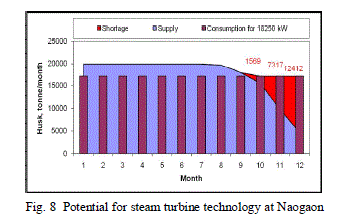 |
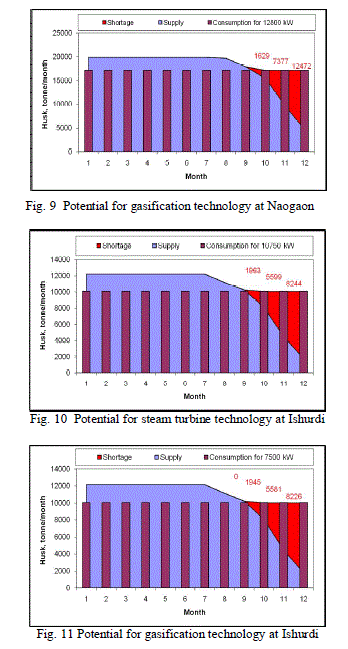 |
CONCLUSION
|
| The study results conclude that there is a potential to produce electricity from rice husk based on the available surplus husk after their own consumption in selected rice processing zones in Bangladesh. Power generated from rice husk is sufficient to meet the power needed for rice processing purposes. The selected rice clusters, Naogaon has better potential than Ishawrdi. Before launching a husk based power generation technology, it is important to know the production and distribution of available rice husk resource at different location. Another important issue is the sustainable supply of rice husk in future for husk based power generation plant. The technological improvement is going on; however, there are some constraints for dissemination of the new technologies. The policy makers, technologists, extension personnel of government and non government organization need to give an urgent thrust for enhancing the dissemination of new renewable energy technologies among the stakeholders. More detailed study can be done by collecting data from other rice clusters zone such as Dinajpur, Sherpur, Gazipur. Generated rice husk ash (RHA) can be analyzed or tested for a wide variety of applications like: green concrete, high performance concrete, refractory, ceramic glaze, insulator, roofing shingles, and bio fertilizers industries. |
| |
References
|
- M. Ahiduzzaman, “Rice Husk Energy Technologies in Bangladesh” Agricultural Engineering International: the CIGR Ejournal. Invited Overview No. 1. Vol. IX. January, 2007.
- Arif Md. WaliullahBhuiyan, Md. Rejwanur Rashid Mojumdar and A K M KamrulHasan, “An Improved Method to Generate Electricity andPrecipitated Silica from Rice Husk: Perspective Bangladesh”, International Journal of Environmental Science and Development, Vol. 2, No. 4,August 2011.
- Jeng-Chyan .M.Lin, “Combination of a Biomass Fired Updraft Gasifier and a Sterling Engine for Power Production”, Journal of EnergyResources Technology, Volume 129, Issue 1, March, 2007.
- D.N. Subbukrishna, K.C. Suresh, P.J. Paul, S. Dasappa, N.K.S. Rajan, “Precipitated Silica From Rice Husk Ash by IPSIT Process”, 15thEuropean Biomass Conference & Exhibition, Berlin, Germany, 7-11 May, 2007.
- Quaak, M., Knoef, H., Stassen, H. “Energy from Biomass: A Review of Combustion and Gasification Technology” World Bank TechnicalReport No. 422. Page 5, 1999.
- Sohel, R. J. SAK, “Economic Sustainability of Solar Home System in Rural Bangladesh” Proceedings of the International Conference onRenewable Energy for Rural Development, Dhaka, Bangladesh, p.266, 19-21 January, 2002.
- Dasgupta, N., Baqui, M. A., Dhingra S., Raman, P., Ahiduzzaman, M. And Kishore, V.V. N., Benefits of Improved Rice Husk Combustion,Bangladesh. NRI report no. 2764.p. 8, 21, 67, 2003.
|